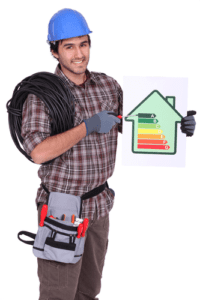You probably rely on your air conditioner or heat pump to provide you with comfort when the weather outside is less than perfect, but how much do you understand about the way these systems operate? If you’re like most people, you probably wish you knew a little more about how heating and cooling systems work. Knowledge is power after all, and the more information you have, the more strategies you might find for using your climate control systems efficiently. One excellent place to start is with all those acronyms you hear HVAC technicians using when they enter your home. For example, what does SEER stand for? If you’re confused, you’re not alone.
SEER stands for Seasonal Energy Efficiency Ratio, but that probably doesn’t satisfy your curiosity. In fact, you might be even more intrigued. What’s a Seasonal Energy Efficiency Ratio, and how does that help you as someone who just wants to stay comfortable in extreme weather without running up the world’s largest utility bill? Fear not: we’re here to provide you with some answers.
What Does SEER Stand For (and More Importantly, Why Does it Matter)?

SEER is one of two standard heating and cooling acronyms that apply to a system’s efficiency. The other is EER, or Energy Efficiency Ratio. Both measurements are important, but for different reasons. Understanding those reasons can teach you a lot about the way your heat pump or air conditioner functions, and whether it uses electricity cost-effectively.
You can find a system’s EER by dividing its Btu rating by its wattage, but that’s not what matters most for AC owners. The most essential thing to remember is this: the EER only measures your system’s efficiency at one constant outdoor temperature. As such, EER is more of a hypothetical number than SEER, because it does not take seasonal changes into account.
The SEER rating on an air conditioner is found by calculating the cooling output of a system during a typical cooling season (still measured in Btu) over the number of Watt-Hours consumed in the same period. These numbers are found using a range of likely outdoor air temperatures, from about 60 to 100 degrees Fahrenheit. SEER values also rely on other variables, such as the average US household’s energy expenditure in the year during which they are assigned. They are then displayed as a value between 8 and 30, with higher numbers representing greater efficiency during an average cooling season.
How Applicable Will My System’s SEER Rating Be?
Most people assume that a SEER rating is more accurate than an EER rating because a larger number of variables are used to calculate it. However, SEER is not always a better indicator of a system’s efficiency. The truth is that SEER ratings may be more or less useful to you depending on where you live.
It’s true that SEER takes seasonal changes into account whereas EER does not. However, the testing conditions for SEER ratings only reflect a certain range of climates accurately. If you live in an area where the weather does not mirror those testing conditions, the SEER rating of your system will not be an accurate indicator of its energy efficiency during a given cooling season.
The average summer temperature in an area where SEER ratings would be most accurate is about 83 degrees. If you live somewhere significantly hotter (in Southern California, for example), then SEER won’t do you much good. However, you can still use EER to help you compare the efficiency of one system against another, since EER only measures efficiency under hypothetical conditions.
Seek Professional Advice
If you’re still confused about the differences between EER and SEER, you may want to turn to an industry authority on the matter. Licensed contractors live and breathe AC specs, and the right ones will be more than happy to talk to you about your system so that you can gain a better understanding of how it works. Contact a company with a reputation for impeccable customer service and give them a few details, such as the region where you live. They’ll tell you whether SEER is an effective way to measure your unit’s efficiency, and whether the unit you have is appropriately energy-efficient for your climate.
Questions like “what does SEER stand for?” might seem a little ridiculous or embarrassing at first, but the truth is that many people want to ask. They just don’t know who to talk to or how the information can help them. There’s a lot to gain by talking to the pros, though. You might learn that your system is not energy efficient for your climate, and save yourself money in the future by replacing it. Conversely, you might discover that your system is perfectly suited to your climate. In that case, you’ll want to make sure you service it properly so that you can continue enjoying the savings it provides. In any case, don’t be afraid to call someone who knows more. Doing so could be one of the coolest decisions you make.
Check with us here at Valley Comfort Heating and Air, our customers love our attention to detail and our friendly, affordable service. (707) 539-4533
